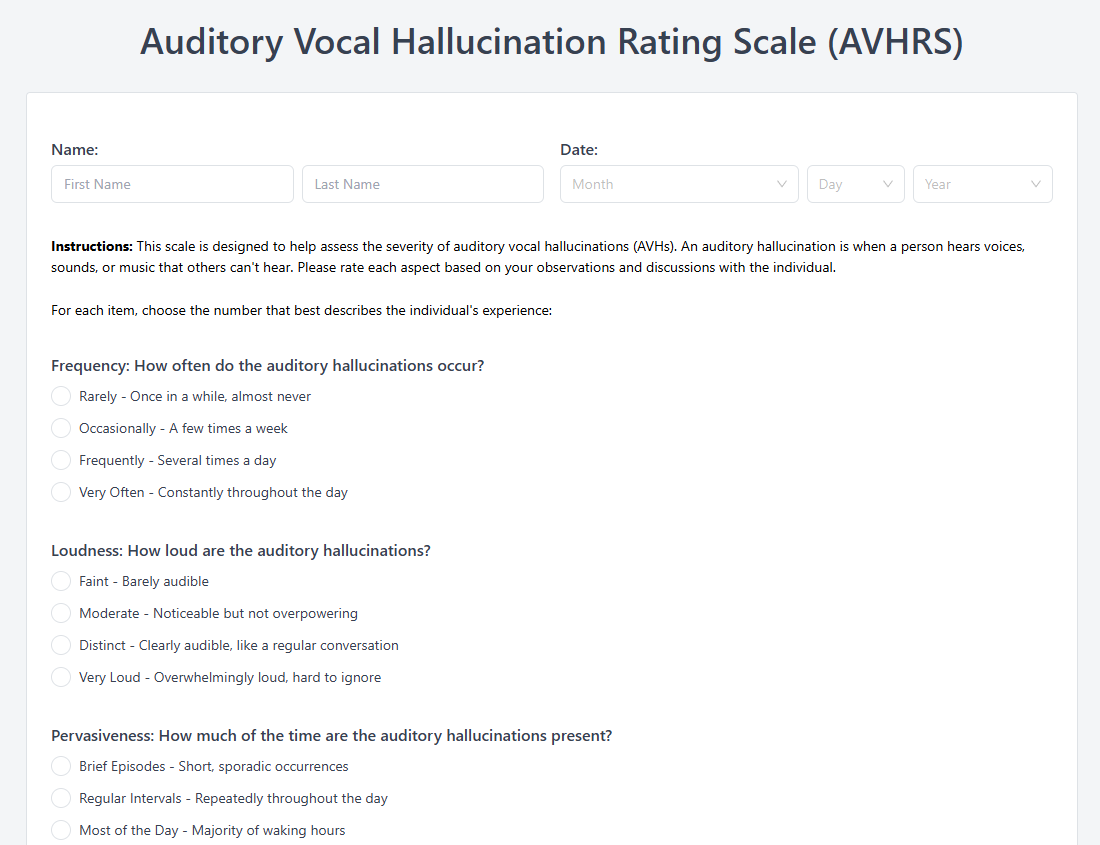

The Auditory Vocal Hallucination Rating Scale (AVHRS) offers a specialised tool to assess the severity and characteristics of voice-hearing experiences. With Zentake’s HIPAA-compliant digital workflow, you can transform the AVHRS into an efficient, secure, and automated assessment.
The AVHRS is a structured clinical interview originally developed by Jenner & van de Willige in 2002 to obtain detailed information about a patient’s auditory vocal hallucinations (AVHs) over a specified time period (e.g., the past month).
Typically the AVHRS consists of roughly 16 items (in its full interview format) that ask about features such as number of voices, frequency, duration, loudness, location (inside/outside the head), control over the voices, distress, and interference.
In its structure you’ll find that each item is accompanied by optional support questions, and the scoring is on an ordered scale (increasing severity) allowing clinicians and researchers to calculate a severity index.
Auditory vocal hallucinations are a core feature of several psychiatric and neurological conditions (e.g., schizophrenia spectrum disorders, schizoaffective disorder) and can have profound effects on quality of life, distress, functioning, and treatment planning. Using a validated scale like the AVHRS helps clinicians systematically quantify voice-hearing experiences and track change over time.
Used in a psychiatric clinic to evaluate a patient newly presenting with voice-hearing experiences; used in a research study of auditory hallucination interventions; or integrated into a neurology program monitoring voice-hearing in epilepsy. External reviews of auditory hallucination measurement instruments confirm that the AVHRS (and its variants) are among the most reliable tools for voice‐hearing assessment.
In a traditional paper-based workflow, the AVHRS interview is administered via printed form or manual entry, manually scored and entered into patient records, often involving delays, transcription error risks and limited workflow integration.
With Zentake’s digital version, the process becomes streamlined:
Before Zentake scenario: Paper form arrives clipped to the patient chart, clinician hand-scores items, manual entry into the record the next day, scoring errors and missing data are common, and tracking change over time is cumbersome.
After Zentake scenario: At intake the clinician opens the digital AVHRS form; patient completes items on a tablet; results auto-populated into the workflow; alerts trigger if severity exceeds threshold; longitudinal dashboards visualize voice-hearing trends.
The improved accuracy, data security, time savings and seamless workflow make digital integration a clear advantage over traditional forms.
Zentake introduces key value-added features for implementing the AVHRS digital form:
Real-world example: A behavioural health clinic incorporated the digital AVHRS into their intake workflow using Zentake. Patients completed the form on a tablet in the waiting room; clinicians reviewed the automatically calculated scores during the session; care coordinators received alerts when distress scores rose above predetermined thresholds; longitudinal graphs helped monitor the impact of interventions.
By transforming the AVHRS into a digital, automated component of care, Zentake helps organisations deliver faster, smarter, and more secure assessment workflows.
For maximal impact when implementing the AVHRS via Zentake:
By combining a validated instrument like the AVHRS with a modern digital workflow via Zentake, healthcare organisations can enhance care quality, patient experience and operational efficiency.
Q1. Who can use the AVHRS?
The AVHRS is designed for clinicians and mental health professionals working with individuals experiencing auditory vocal hallucinations. With Zentake, the form can also be used by care coordinators, research teams or any authorised users in healthcare organisations.
Q2. How long does it take to complete?
When administered digitally through Zentake, most patients complete the AVHRS in approximately 15–20 minutes. The streamlined digital version often reduces completion and scoring time compared with paper forms.
Q3. Is the AVHRS scientifically validated?
Yes. Research confirms that the AVHRS is reliable and valid: one study found strong internal consistency and inter-rater reliability in clinical and non-clinical samples. (Cambridge University Press & Assessment) The self-report version (AVHRS-Q) also demonstrates good convergent validity (r = 0.90 with the AVHRS) and is suitable for both clinical and research settings. (PubMed)
Q4. Can I export results from Zentake?
Yes. With Zentake’s digital form, you can export results in various formats (CSV, PDF) for integration with electronic health records, research databases or quality-management dashboards.
Q5. How is this form integrated into patient workflows?
Zentake enables seamless integration: send secure links to patients pre-visit, use tablets in the clinic, automate scoring, trigger alerts or next steps based on severity, and store data securely for longitudinal tracking and analytics.